|
Classic Camera Collectors Club Informatif website of Frank Lakiere |
CHAPTER 1 : From Aristotle to Eastman
CHAPTER 2 : Important persons in the history of photography
2.2. Jean Francois Antoine CLAUDET(1797-1867)
2.3. Louis Jacques Mandé DAGUERRE (1789-1851)
2.4. Sir Humphrey DAVY (1778-1829)
2.5. George EASTMAN (1854-1932)
2.6. Antoine Hercule Romuald FLORENCE (1804 - 1879)
2.7. Sir John HERSCHEL
2.8. Dr. Richard Leach MADDOX (1816-1902)
2.9. Joseph Nicéphore NIÉPCE (1765-1833)
2.10. Abel NIÉPCE DE SAINT VICTOR (1805-1870)
2.11. Josef Max PETZVAL (1807-1891)
2.12. Johann Heinrich Schulze (1687-1744)
2.13. Frederic SCOTT ARCHER (1813-1857)
2.14. William Henry Fox TALBOT (1800-1877)
2.15. Thomas Wedgwood (1771-1805)
2.1. Robert BOYLE (1627-1691)
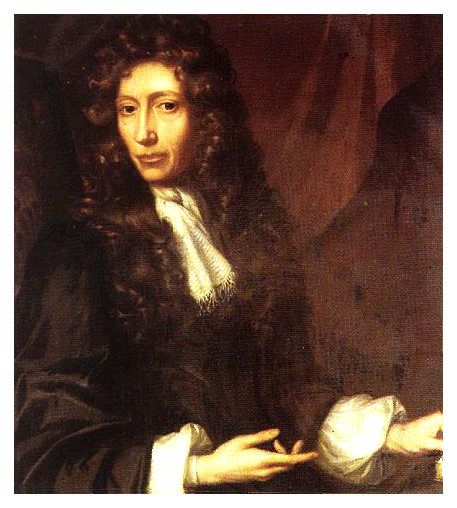 Robert Boyle was the 14th child of an important Irish family and so he got a very good education at Etobn College.
Robert Boyle was the 14th child of an important Irish family and so he got a very good education at Etobn College.From 1639 to 1645 he made a grand tour of Europe witha private teacher and he stays in Switzerland for a long time.
Between 1656 en 1668 Boyle is student at Oxford University. Witht he aid of Robert hooke he there constructs an air-pump with which he does lots of experiments regarding the physical characteristics of air.
He also shows the importance of air in combustion, in respiration and in the propagation of sound.
Boyle was one of the founding fathers of the Royal Society and he also was director of the East-Indian Company.
He is one of the first scientist to perform scientific experiments. His name will of course always be linked to the invention of the gas-laws (The Law of Boyle-Mariotte: At a constant temperature the volume of a gas is opposite proportional to the pressure).
But Boyle was also active in chemistry. Until the middle of the 17th century the foundation of chemistry was alchemy, theosophy and medicine.
The alchemists believed in the existance of 3 principles : sulfur, mercury and salt.
Boyle was opposed to this believe, but he also was opposed to the old theory of Aristoteles that stated that there are 4 basic elements : fire, water, air and earth.
He defined the term 'element' as a particle that cannot be devided any further. According to Boyle the different substances occur because of differences in the number, the movement and the position of these primary particles (the corpuscules).
Boyle did not postulate that there are differences in the primary particles, but even then his theory is still valid between certain limits.
For the photography we have to include the publication : 'Experiments and considerations touching colours' from 1664.
Boyle states herein that light consists of matter and that warmth can be weighed. He also describes various chemical experiments with colours. Experiment XXXVI is very important in the history of photography.
This experiment describes how to make a deposit of silverchloride and the phenomenon of the darkening of the deposit.
But Boyle makes the assumption that the darkening is due to the air and moisture and not to the light.
The most important thing in this work is that Boyle describes his experiments very clear and to-the-point. This is a geeat contrats with his contemporaries who have a style of writing that is confuse, mystical and extravagant.
Boyle was a famous scientist in his life-time. He was choosen president of the Royal Society in 1680 but he declined the honour.
As a religiouos protestant Boyle supported the translation of the New Testament into Irish and into Turkish. In 1690 he published 'The Christian Virtuoso' in which he explained his view on theology. He saw nature as a big mechanical work that was started by the Creator and that now functioned following secundary laws. These laws can be studied by scientists, but the human soul is immaterial and more noble than the moving particles that the body is made of.

2.2. Jean Francois Antoine CLAUDET (1797-1867)
Claudet was one of the first commercial photographers. He was a Fench glass-merchand living in High-Holborn. Claudet learned the technique of the daguerreotype from Daguerre himself and he bought a licence to work with the technique in England. In 1841 he installed a studio on the rooftop of the Adelaide Gallery, not far from the church of St. Martins-in-the-Fields.
Later he installed two more studios.
In this same period another photographer, Beard, was active in London. The concurrence was fierce and Beard even tried to shut down Claudet's studios by prosecuting Claudet. But in the end Claudet won the case.
The exposure time was very very long en the person to be portrayed had to remain still for a considerable amount of time.
Thomas Sutton who posed for his portrait described this ordeal : 'I sat there... in the blazing sunshine en after approximately one minute the plate was developed... My eyes were staring until the tears were streaming out and so the portrait was a caricature... I paid a guinea for it. It since has faded...'
In 1842 Fox Talbot tried to convince Claudet to use the calotype (or Tabotype) technique. Claudet tried it a few times but without great success. He wrote about it to Talbot:
'Until we have a paper that is equally even and perfect as a silverplate, the daguerreotype will give images that are more delicate, more refined and more perfect than the talbotype. Until we will reach exposure times of a few seconds with talbotype and work as fast as with daguerreotype so that the pose will be more agreable, the advantage will be for the daguerreotype. But one also has to say that the talbotype has his own advantages : the photographs are easy to transport, it is possible to send them by mail, it is possible to mount them in albums,etc... and it is possible to reproduce them in large numbers.' Claudet performed his own experiments and by using bromide instead of chloride he could shorten the exposure time.
He also invented the dark room safelight and he was the first to use a sequence of photographs to create the illusion of movement.
The first use of a painted background is also attributed to Claudet.
In 1845 he buys a lens that was developed by Petzval. This lens was 16 times faster than the lenses he used until then. And now Claudet could use shorter exposure times and also make bigger photographs. He was able to make a portrait photo with an exposure time of 15 sec.
In 1851 he moved his studio to Regent Street and built there the 'Temple of Photography'.
Later he became fascinated by stereoscopic photography. He invented a foldable stereoscope en a stereoviewer in which one could see 100 successive stereopictures. He wrote about this : 'The stereoscope gives a general panorama of the world. It is very cheap and very easy to get not only an image, but also a model in an almost tangible form of all what exists in the different states of the world.'
Claudet was awarded many honours as well in England as in France.
In 1859, less than a month after his death, the Temple of Photography was destroyed by fire and a great deal of the photographic treasures of Claudet were lost.

2.3. Louis Jacques Mandé DAGUERRE (1789-1851)

As a painter of dioramas Daguerre was very much interessed in the possibility of making lasting images of the furtive images in the camera obscura.
His wive feared that he was becoming mad and in 1821 she went for advice to Jean Dumas, professor at the Sorbonne in Paris. The professor reassured her that it was O.K. " With the the scientific knowledge that we have today this is impossible, but I do not think that it will remain impossible forever", Dumas said to her.
In 1829 Daguerre and Niépce decide to cooperate. They perform their own experiments but do not make much progress.
But in 1835 Daguerre discovers by accident that a sensitised silverplate that was exposed to light was developed by mercury vapour. On the silverplate appeared a positive image . But only 2 years later was he able to fix these images.
On the 13th of june 1837 Niépces son and Daguerre agree that the new process will have the name of Daguerre.
They also want to found a company that must commercialise this invention.
They try to sell 400 shares but there is little interest and so they decide to seel the invention to the French republic.
On the 7th January 1839 the daguerreotype is presented to the Academy of Sciences and the day after the Gazette de France reports on this technique, but without much technical details.
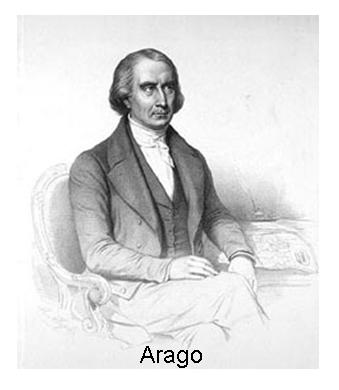
Fox Talbot who in England was doing also experiments on photographic images decided then to hurry and present his technique (the calotype) to the Royal Society.
In 1839 the French gouvernment, on instigation of Arago, decided to buy the rights of the technique invented by Daguerre.
Op 19 august of the same year the process was published and the French gouvernment donated it to the world.
But 5 days earlier Daguerre was able to have a patent on his process in England.
The daguerreotype gives a positive image on a polished metal plate.
The process works as follows:
1. a copperplate is covered with a sheet of silver and polished until it looks like a mirror.
2. in a camera the silvered copperplate is put into contact with jodine vapour.
3. Jodine reacts with silver to form a layer of lightsensitive silverjodide. The plate now has to be used within an hour.
4. the exposure takes 20 to 30 minutes depending on the available light.
5. the plate is developed by holding it above a mercury bath, warmed to 75 degrees Celsius. 6. the mercury vapour reacts with the silver and forms silver-amalgamate.
7. the image formed by the amalgalate is fixed by washing of the plate in a warm solution of salt.
8. the plate is washed in warm destilled water.
After developing, fixing and washing the image is milky-white.
The first plates were 8,5 by 6,5 inches (22 x 16,5 cm) and this was called a 'full plate'.
The quality of a daguerreotype image is astounding but the process has a few disadvantages:
1. it is impossible to reproduce the images. Each daguerreotype is unique.
2. the surface od the siver mirror is very delicate. And there is a danger that due to atmospheric corrosion the silverlayer gets loose from the copperplate. That is why daguerreotypes are usually mounted in special sealed cases.
3. the image is mirrored (left becomes right). Later some cameras are using mirrors to correct this.
4. the chemicals involved (mercury and jodine, mater also chlorine and bromine) are very poisonous and difficult to use safely.
5. there is a very limited angle to look at a daguerreotype and have a good view of the image.
Many of the daguerreotypes that have survived are remarkable by the rendering of fine details.
Jean Louis Gros, an amateurphotographer, was one of the first to make photos of the Parthenon in Athens. When he was back in Paris he ddiscovered that on the photos he could study details of statues that he had not seen when he took the picture.
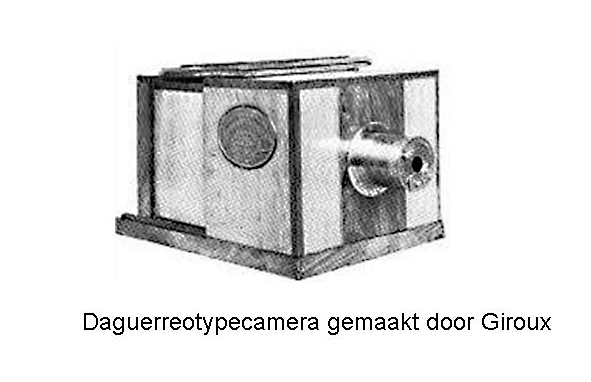
Fox Talbot, Daguerre's rival, writes about this: " It often happens, and that is one of the charms of photography, that the photographer while studying the photo, sometimes a long time afterwards, sees that he has recorded things of which he had no notion at that time. Sometimes there are inscriptions and dates on buildings or posters, that are totally senseless, or on walls. Sometimes one sees in the distance a clockface with on it, unintentionally recorded, the hour of the day on which the picture was taken."
The problem of the very long exposure time (10 to 15 minutes in full sunlight) made that the technique was not suitable for making portraits;
Posing for a portrait was no laughing matter!!
In 1839 John W. Draper of New York made the first portait photograph. To shorten the exposure time the face of the person was poudered with white flour and even then he had to sit still for 30 minutes in sunlight posing in front of the camera. It is no wonder that in these early portraitphotos the spontanety is absent.
There was need for a more effectieve way to shorten the exposure time and this was achieved by two inventions:
- On the chemical one created plates with greater sensitivity by using bromine (J.C. Goddard) and chlorine (A. Claudet) togeteher with jodine.
- On the optical side there was a great breakthrough with the portraitlens of Petzval. This lens had a maximal disphragm of f/3.7 instead of the f/17 of the Chevalier lens that was used by Daguerre.
In fact the Austrian professor Andreas von Ettinghausen was convinced from the beginning of photography that the biggest problem was these long exposure times with the primitive lenses that were used. He spoke about this with his colleague Max Petzval, professor in de mathematics, and he introduced Petzval to Peter von Voigtländer who owned an important optical store in Vienna.
After a year of thinking and calculating Petzval had developed a totally new lensdesign. This Petzval-portraitlens was 16 times faster than the lens used by Daguerre. The Petzvallens was to be the standard portraitlens for the next decades.
Voigtländer mades thousands of these lenses for its own cameras and for numerous other camera manufacturers. But he also designed a new camera. The clumsy wooden box used by Daguerre was changed to a small handy metal camera.
Becuase of the great success Voigtländer had to expand and he built a new factory in Germany. That laid the fundament of the german photographic industry.
With all these improvements the exposure time was reduced to a few seconds and that made portraitphotography possible.
In England, where the patent of Daguerre was valid until 1853, the first licence was delivered to Antoine-Jean-Francois Claudet. He opened a studio in june 1841. His Daguerreotypes are among the best that were made in Great-Britain and he was also responsible for progress in the photographic process. He invented a more sensitiveplate by using chlrine together with jodine and he also itroduced the stereoscopic daguerreotype in 1851.
He also discovered that these plates are insensitive to red light and that it is possible to use a red darkroom light without affecting the sensitive plates.
The end of the patent in 1853 made that lots of photographers started their own bussiness.
The daguerreotype, also called 'A mirror with a memory' was an impressive technique with great imagedetail, but nevertheless it was a dead end street.

2.4. Sir Humphrey DAVY (1778-1829)
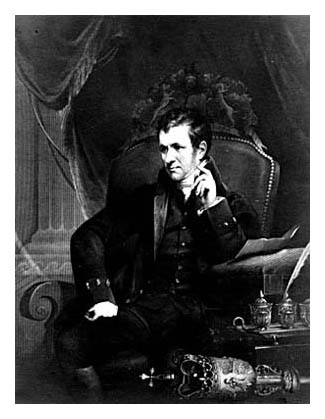
When Davy was 16 he worked for a surgeon-pharmacist. In this way he learned about the work of Lavoisier and he became interested in chemistry.
Davy later became one of the most famous chemists of his time.
His first success came with his research on nitrogenoxides and their practical medicinal use. He discovered the anaesthetic properties of nitrogenmonoxide (NO) that is best known as 'laughing gas' and that was generally used by dentists.
More important was his research in electrochemistry.
By using electrical current Davy found that some substances could be split into their elements (=electrolysis). From this experiment Davy concluded that the elements in a substance were kept together by electrical forces.
He later was able to isolate different alkalimetals, like sodium, potassium, magnesium, calcium, strontium and barium.
He also conducted some research regarding chlorine and jodine.
But in the mean time he invented the Davy-lamp, better known as the mineworkers-lamp. This lamp increased the safety of mineworkers : the Davy-lamp prevented the risk of explosion with minegas.
The importance of his work in the field of photography is limited to his co-operation with Wedgwood.
This led to the publication of 'An Account of a Method of Copying Paintings on Glass, and Making Profiles, by the Agency of Light upon Nitrates of Silver'.
This paper describes the production of silverchloridepaper. That will be used later by Talbot in the calotype process.
Davy is the first to report on the registration of magnified images by a microscope and is thus the inventor of photographic magnification.
In 1827 Davy became very ill, due to the breathing of al kinds of harmful gases. He first moved to Rome where he got a heart attack and he finally died in Geneva on the 29th of may 1829.

2.5. George EASTMAN (1854-1932)
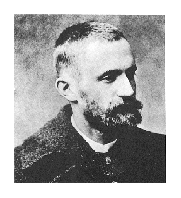
George Eastman was born on the 12th of july 1854 as the youngest of 3 children. When he was 5 years the family moved to Rochester where his father founded the Eastman Commercial College stichtte.
But his father dead also meant the end of the school.
The financial situation of the family was such that George just 14 yaers old had to go to work as an office clerk and in the evenings he studied accounting to get a better paid job.
In 1876 was Eastman planned to go on a trip to Santo Domingo.
When one of his colleagues suggested to make a photographic report of the trip, Eastman bought a full installation for wet-plate photography.
The camera was as big as a microwave oven and he needed to have a big, heavy tripod. Then there was the black tent to pour the photographic emulsion onto the plates just before use. And of course there were the chemicals, the glass vessels, a water tank, ...
Eastman finally did not make the trip to Santo Domingo but he got hooked to photography. He especially was interested in ways to make the technique easier to use.
In British magazines eastman learned about photographers who had their own procedures to make gelatine emulsions. The plates that were coated with this emulsion were usable even when dried.
After his work in the office, he experimented in the kitchen until the early hours and started making his own gelatine emulsion.
It took him 3 years to find finally a formula that worked well. And in 1880 Eastman not oly had the emulsion but he also had invented and patented the machinery to produce the dry plates.
The Eastman Dry Plate Company started to sell the plates in april 1880.
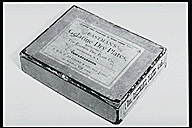
This was only the beginning. Eastman wanted to use a more less breakable and lighter material than the glass plates. He first used a paper tape on which he poured a layer of soluble gelatine. On top of this layer came the light-sensitive gelatine emulsion. After the exposure and development one had to remove the gelatine layer onto another layer of clear gelatine. These combined layers were thzen treated with collodium to make it a hard film.
the real success of the rollfilm began in 1888 when eastman marketed the KODAK camera with the text : 'You press the button, we do the rest! '
From then on everybody was able to take photographs without having much technical skills.
Here is a photograph of Eastman and Edison together using a film camera
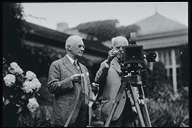

2.6. Antoine Hercule Romuald FLORENCE (1804 – 1879)

Antoine Florence was a French-Brazilian painter and inventor, known as the isolate inventor of photography in Brazil, three years before Daguerre (but six years after Nicéphore Niépce), using the matrix negative/positive, still in use.
According to Kossoy, who examined Florence's notes, he referred to his process, in French, as "photographie" in 1834, at least four years before John Herschel coined the English word "photography".
Hercules Florence was born on February 29, 1804 in Nice, France, the son of Arnaud Florence (1749-1807), a tax collector, and Augustine de Vignolis, a minor noblewoman.
As a child he manifested interest for drawing and the sciences, as well as for the voyages of the great explorers to the New World.
As a 14 year-old boy he already worked as a calligrapher and draftsman in Monaco, where his parents had been living since 1807.
After a period of wandering and working on board of warships and merchant ships, Hércules Florence set sail to Brazil as a crew member of the French warship Marie Thérèze, arriving in the port of Rio de Janeiro on May 1, 1824, two years after the declaration of independence from Portugal. He was already an accomplished draftsman and painter with considerable talent and many scientific interests, particularly in the natural sciences and ethnography. Soon after his arrival, he got a job in a women's fashion store and then as a lithographer in a bookstore and printing shop, owned by his compatriot Pierre Plancher.
The great Langsdorff expedition
Florence's life changed dramatically when he decided to respond to a newspaper advertisement put by Baron von Langsdorff (1773-1852), the consul general of the Russian Empire in Brazil, a German-born physician and naturalist who was organizing a scientific expedition to the Amazon, on behalf of the Russian Imperial Academy of Sciences .
He was hired as an illustrator and topographic draftsman, together with German painter Johann Moritz Rugendas (1802-1858) and the young French illustrator Adrien Taunay (1803-1828). In the year of 1825 they travelled by sea from Rio to the village of Santos. While they waited for the set day of departure to the Amazon, Florence and other members of the scientific expedition spent their days exploring the coastal lowland areas, such as Cubatão, and the high-rising plateau beyond the imposing Serra do Mar and they visited the towns of São Paulo, Juqueri, Jundiai, Itu and Campinas.
From 1826 to 1829 he accompanied Langsdorff's expedition and he was the only artist to arrive at Belém (Pará) and return unscathed to Rio.
His vivid and detailed illustrations, drawings and watercolors picturing the local flora and fauna, the landscapes and especially the many inhabitants and Indians met during the voyage were very important for the documentation of Langsdorff's voyage, as well as for his subsequent career.
Back to Rio, Florence left the manuscript of his diary of the expedition, with 84 pages (written in French) with Félix Taunay (1795-1881), the brother of his companion Adrien. The manuscript was translated to Portuguese and published by the son of Félix, the historian Alfredo D´Escragnolle Taunay in 1875, more than 40 years later.
In 1849, Florence completed his description of the fabulous adventure, which was published for the first time in 1977, under the title "A Fluvial Voyage from Tietê to Amazon Rivers, through the Brazilian Provinces of São Paulo, Mato Grosso and Grand-Pará (1825-1829)".
Florence as businessman and inventor
Soon after the end of the expedition, in 1830, Florence married Maria Angélica de Vasconcellos, the daughter of his acquaintance and benefactor Francisco Álvares Machado, and went to live with her in the small city of Campinas (then named the village of São Carlos), in the province of São Paulo. There he became a successful farmer, publisher and owner of the first printer in the town, and in Campinas he remained for the next 49 years until his death in 1879.
Maria died in 1850; four years later he married Carolina Krug, a German immigrant born in 1828 in Kassel. Together they founded in 1863 a school for girls, the Florence College, which was moved to Jundiai after Hercule's death. He fathered a total of 20 children (13 with Maria Angélica and 7 with Carolina).
Soon after settling in Campinas, Hércules Florence began a prolific career as inventor and businessman.
During the Langsdorff expedition, he had developed a new system of using musical notation to record the songs of birds and vocalizations of other animals, which he named "zoophonia".
In 1830, when he was searching for a simplified way of printing his more than 200 illustrations performed during the Langsdorff Expedition, other than using expensive and time-consuming engravings on wood and metal (xylography and lithography), he invented a new process. This is similar to the mimeograph, which he named "polygraphia", and began using this commercially in his printing office. As his technique evolved, he was able to combine colors, and to produce uncounterfeitable bank notes.
In 1832, with the help of a pharmacist friend, Joaquim Correa de Mello, he began to study ways of permanently fixing camera obscura images, which he named "photographia".
In 1833, they settled on silver nitrate on paper, in a process very similar to that developed by Niépce and Daguerre.
Unfortunately, partly because he never published the invention adequately, partly because he was an obscure inventor living in a remote and underveloped province, Hércules Florence was never recognized internationally as one of the inventors of photography.

2.7. Sir JOHN HERSCHEL
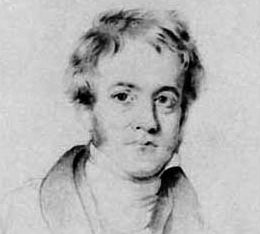
Sir John Herschel was the first one to use the words 'photography' and 'photographic' during a lecture for the Royal Society in Londen at the 14th of march 1839.
(Niépce used the term 'heliographic' and Talbot used the term 'photogenic')
In 1840 Herschel desribes how paper that is soaked in a solution of silvernitrate, silverchloride and silverbrmide reacts in sunlight. He discovers that silverbromide is much ore light-sensitive than the other silver salts.
Herschel published the results in 'On the Chemical Action of the Rays of the Solar Spectrum on Preparations of Silver and other Substances, both Metallic and Nonmetallic, and on some Photographic Processes.'
Already in 1840 Herschel mentioned that 'we must create a new photography based on silverbromide.' !!
In another publication in 1842 'On the Action of the Rays of the Solar Spectrum on Vegetable Colours and on Some New Photographic Processes'
Herschel describes for the first time the iron process with ammoniumcitrate. He describes the process with blue lines on a white background and the process with white lines on blue background (the so-called blueprint). Herschel also discoverd the chrysotype process that uses the exposure of iron salts followed by a development with gold- and silver solutions.

2.8. Dr. Richard Leach MADDOX (1816-1902)
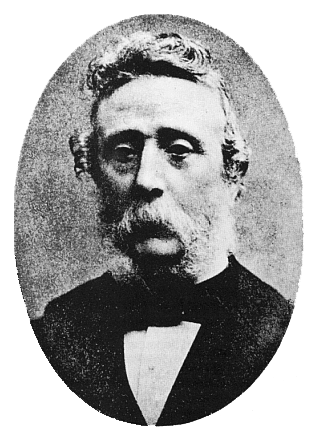
The first description of a satisfactory system with dry plates comes from Richard Maddox. He was interested in photographical experiments and had observed that the fumes from the liquids used in the wet-collodion process were harmful.
Therefore he he did some research to find a replacemnt for collodion.
Others had already tried to use gelatin but had failed to make it into a working process.
Maddox used silvernitrate and mixed it with calciumbromide in a warm gelatin solution. In that way he made a silverbromide solution. When poured on glass plates and dried this gelatine-silverbromide dry plates could be exposed after a longer period of time.
Maddow published his findings in the British Journal of Photography on 8 september 1871. The results were still far from optimal but other researchers developed this technique and did more experiments with dry plates.
Finally in 1878 experiments by Charles Bennett made a breakthrough : a silverbromide-gelatine emulsion like that used by Maddox was kept warm at 32°C for some days. This is called the ripening of the emulsion and it leads to a important increase in sensitivity.
It became possible to make snapshots with an exposure time of 1/25th of a second.
From now one had dry plates that combined ease of use, high sensitivity and longueviety.
The photographer was able to go out to make photos carrying only a camera, a tripod and a box with dry plates. Within a year the wet-plate process had disappeared.

2.9. Joseph Nicéphore NIÉPCE (1765-1833)
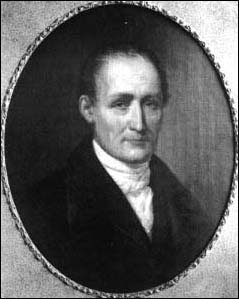

Niépce en zijn camera obscura.
This French inventor was born at Chalons-sur-Saône and began experimenting with photography together with his brother Claude in 1793.
In 1826 he realised the first lasting photographic image : the garden of his house in Chalons.
He technique was as follows :
First he covers a polished tin plate with a thin layer of bitumen (also called Jodenasphalt).
The plate is placed in a camera obscura and is exposed.
The exposure time on a bright sunny day is at least 8 hours !!
The sunlight makes the bitumen hard and makes it insoluble in a mixture of lavenderoil and light petrol.
By washing the plate in this mixture the bitumen is washed away in places that were not exposed to sunlight. That way a positive image remains on the tin plate.
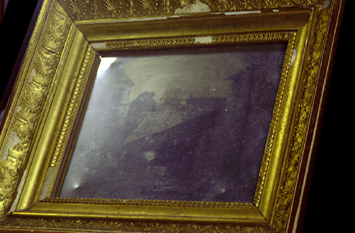
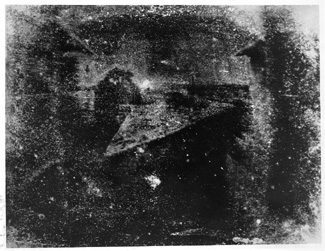
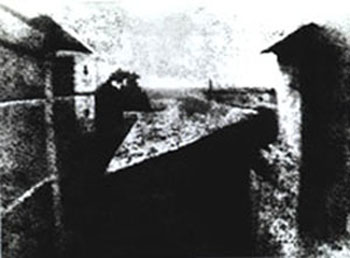
Niépces first photo : original and copies
The framed photo is the original. Beneath it at the left is a silverprint copie made in the Kodak Research Laboratories in Harrow, England in 1952. This copies shows much higher contrast than the original and the texture of the tin plate is visible.
That is why this photo was retouched with aquarel to have a copy that is more similar to the original.
This last copy is the most renowned reproduction of Niépce's first photo.
The original can be seen ar the University of Austin, Texas
Niépce also did research on other topics. He also worked on a better version of the irisdiaphragm.

2.10. Abel NIÉPCE DE SAINT VICTOR (1805-1870)
Claude Félix Abel Niépce de Saint Victor is the nefew of Nicéphore Niépce. Als lieutenant in het French Army he had a laboratory of chemistry in Saint Martin, a small town next to Paris.
In 1847 he made an important discovery for the use of glassplates.
Abel Niépce de Saint Victor made experiments with several products to put the sensitive layer on a glass plate. He used starch, eggwhite, gelatine,...
He stopped using gelatine because the gelatine-layer came loose when put into the acid silvernitrate bath.
His successful process :
First he made a mixture of eggwhite and potassiumiodide. The plate is covered with this mixture and dried.
Then the plate is placed in a silvernitrate solution. The eggwhite coagulates and on the glassplate a layer of silveriodide is formed.
After exposure the palte is developed in a gallic acid solution (trihydroxybenzoic acid).
Later this developer was changed to pyrogallic acid. (benzenetriol)
The sensitivity was enhanced by adding sugar sirup or hiney to the eggwhite.
Because the glass plates were 100% transparant the negatives were much better than these produced by using waxed paper.
But the albumen process was not much more sensitive than the daguerreotypy and the technique was cumbersome. Also the results were more or less unpredictable.
After 1870 the albumen negative technique was replaced by the wet-collodion plates.
The albumen technique was still used for some time to produce transparants and dia-positives for projection in magic lanterns.
Abel also improved the asphalt-process of Nicéphore and this was the beginning of modern héliogravure, a technique using chemicals to make printing plates for intaglio engraving. The work is reproduced on metal by photographic transfer.
In 1848 he publishes his 'Traité pratique de gravure héliographique sur acier et sur verre'.
Even after he left the army he still experimented in the domain of scientific photography until his dead in 1870.

2.11. Josef Max PETZVAL (1807-1891)
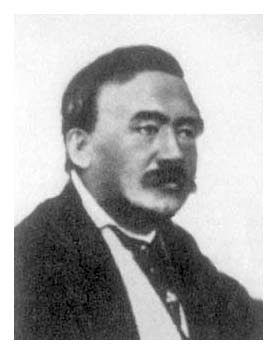
The camera of Daguerre had a so-called Wollaston-Chevalier lens.
This type of lens was used with practically all daguerreotype cameras but the lens was rather primitive : a slow lens which means that it is not very bright and it also gave not very sharp images with fully open diaphragm.
Petzval studied these lenses and decided to design a new type of lens with larger diaphragm and better image quality.
Petzval was born in Hongary in 1807 and after his studies as an engineer at the University of Budapest he became professor in mathematics in 1835.
In 1837 he went to the University of Vienna.
Petzval designed 2 new lenstypes : the first was a so-called portraitlens and with a diaphragm of 3.6 it was 16 times faster than the Chevalier-lens.
The second lens a so-called orthoscope was used for landscape and architectural photography. This lens was not as fast as the portraitlens but gave a larger field of view and sharper images.
To make the necessary calculations Petzval needed the help of several assistants. The archduke Ludwig decided that several soldiers of the engineering corps, who were especially trained in mathematics, could help Petzval.
And so the portraitlens was designed and in 1840 it was made and marketed by Voigtländer. And with more lightsensitive jodobromide and jodo-chloro-bromide plates it was possible to make a portrait with an exposure time between 15 and 30 sec.
These first portraitlenses ware rather small and had a diameter of 2,6 cm. In 1856 Dietzler made a Petzval lens with a diameter of 6 inches (= 15 cm) and with a weight of approx. 15 kg. With this lens it was possible to make negatives of 13x16 inches (= 33x42 cm).
At the international photographic exhibition of 1865 in Berlin a camera with an 8 inch lens was presented. The camera with lens and tripod weighed more than 100 kg.
In Paris Disdéri even gave a demonstration with a camera with a Petzval-lens with a diameter of 27 cm (almost 11 inches) and the collodionplates he used were 60x80 cm large.
The landscape-lens (orthoscope) was further improved by Petzval and in 1857 it was marketed as Photographischer Dialyt.
But hereafter Voigtländer and Petzval disagreed over who had the rights on the design. From then on Petzval worked with Dietzler but he went bankrupt and from then on Petzval worked on its own.
Unfortunately in 1859 a burgler destroyed a complete manuscript that was dedicated on optics and from then on Petzval changed his research and worked further on acoutics.
In 1862 Petzval also stopped his teachings on light refraction. In 1869 (aged 62) he married but his wife died only 4 years later.
In 1877 Petzval resigned as professor. He withdrew from public life and became lonesome and misanthrope.
He died in 1891 embittered by its dispute with Voigtländer, by the bankruptcy of Dietzler and by the lack of recognition for his work on applied optics.

2.12. Johann Heinrich Schulze (1687-1744)
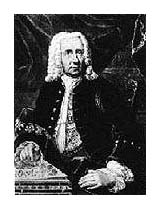
J.H. Schulze was working on many different subjects.
He was interested in physiology, anatomy and the history of medicine, but also in archeology, eastern languages and the history of the arts.
In 1725 he began to do some research regarding light-emitting or phosphoresent minerals. Two years later he publishes his findings. In this publication he remarks that '... we often find something by accident what we would not have found when searching targeted.'
For during his research to find a stone that would absorb sunlight and then afterwards would emit the light again he discovered a substance that became black when exposed to sunlight. That substance was a precipitate that occured when mixing nitric acid with lime and with the addition of some parts of silver.
By further experimenting with direct sunlight, mirrors, lenses and warmth Schulze proves that the blackening is a result of the influence of light and of light alone. He also proves that the silver parts are responsible for the discoloration.
Schulze concludes : '... this experiment can be used to prove that minerals or metals contain silver, because the phenomenon has not been seen when other metals were tested in this way.'
And Schulze also states that this experiment will probably inspire scientists to find other applications .

2.13. Frederic SCOTT ARCHER (1813-1857)

In the magazine The Chemist in 1851 F. Scott Archer describes a new photographic technique that makes use of collodion. Collodion is a solution of nitrocellulose in ether.
The process is as follows:
First some potassiumiodide was dissolved in collodion en this solution was poured very evenly on a clean glassplate.
The ether evaporates quickly and soon it leaves a sticky surface.
At that moment the plate is immersed in a silvernitrate solution. This forms silveriodide and from now on the plate is sensitive to light and can now exposed in the camera.
This must be done while te plate is still wet because when dry it looses most of its sensititvity.
After exposure the plate is directly developed, fixd and washed.
This technique is not easy to perform but it has one big advantage : the sensitivity of the plates is much higher and so the photographer can use very short exposure times.
In 1852 Archer describes a variant:
By treating the glass negative with mercurychloride and then placing the negative on a black bacjground a positive image could be seen.
This technique is called ambrotype and it was used a lot for portraits.
During his life Scott Archer never had any financial benefits from his invention.
He died very poor in 1857 while he had lived to see that his invention had revolutionized the photography.

2.14. William Henry Fox TALBOT (1800-1877)
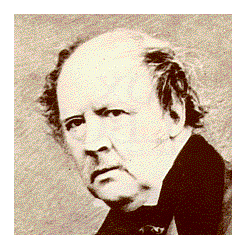
Talbot was a philosopher, egyptologist, mathematician, fylologue, physician and photographer.
The idea of making images by using some kind of camera came when he was for a holiday in 1833 in Italy at the Como lake, where he used the camera obscura and the camera lucida as while making sketches of the landscape.
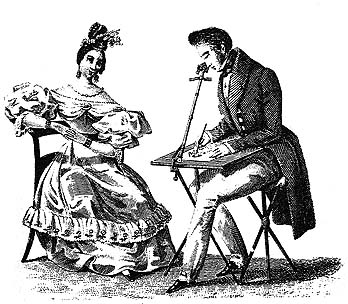
The use of the camera lucida
Talbot writes about this : '... I was amusing myself on the lovely shores of the Lake of Como in Italy, taking sketches with a Camera Lucida, or rather, I should say, attempting to make them; but with the smallest possible amount of success... After various fruitless attempts I laid aside the instrument and came to the conclusion that its use required a previous knowledge of drawing which unfortunately I did not possess.
I then thought of trying again a method which I had tried many years before. This method was to take a Camera Obscura and to throw the image of the objects on a piece of paper in its focus - fairy pictures, creations of a moment, and destined as rapidly to fade away... It was during these thoughts that the idea occurred to me... how charming it would be if it were possible to cause these natural images to imprint themselves durably and remain fixed on the paper!'
Between 1834 and 1850 Talbots work laid the basis for the photography technique that consists of making negatives on a film and then making numerous positives from this negative.
Niépce has made the first photographic image in a camera obscura with an exposure time of 8 to 10 hours.
Daguerre made photographs using a copper plate, with a polished silver surface that was made lightsensitive with iode fumes and developing the plate with mercury fumes.
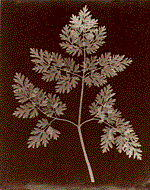
Annoyed that Daguerre had been put in the lime-light he felt he himself deserved, Talbot began to publicise his own process.
On 25 January 1839 he announced the discovery at the Royal Institution of a method of photogenic drawing.
He made photographs using paper that was first immersed in a salt solution and after drying the paper was made lightsensitive by treating it with silvernitrate.
Later, in September 1840 Fox Talbot discovered the phenomenon of the latent image. It is said that this was a chance discovery, when he attempted to re-sensitise some paper which had failed to work in previous experiments; as the chemical was applied, an image, previously invisible, began to appear. This was a major breakthrough which led to drastically lowered exposure times - from one hour or so to 1-3 minutes.
Talbot called this technique calotype (from the Greek 'Kalos', meaning beautiful) and on 31 January he sent a paper to the Royal Society of London. The paper was entitled 'Some account of the Art of Photogenic drawing, or the process by which natural objects may be made to delineate themselves without the aid of the artist's pencil.'
In 1844 Talbot began issuing a book entitled 'The Pencil of Nature', the first commercial book to be illustrated with actual photographs.
Talbot's process in general never reached the popularity of the daguerreotype process, partly because the latter produced such amazing detail, but partly because Talbot asked so much for the rights to use his process.
Sadly Talbot's name was somewhat tarnished by his attempts to enforce his patent. A claim in 1854 that the Collodion process was also covered by his calotype patent. was lost in court, and from then onwards, knowing that the faster and better collodion process was free for all to use, there were no further restrictions and photography began to take off in a big way.
Talbot summarised his achievement with these words:
'I do not profess to have perfected an art but to have commenced one, the limits of which it is not possible at present exactly to ascertain. I only claim to have based this art on a secure foundation.'
A web-site led by Professor Larry J. Schaaf is probably the definitive site regarding this remarkable inventor.
It is part of a three year project and it is a must for any student of Talbot.
The URL of this site = www.foxtalbot.arts.gla.ac.uk

2.15. Thomas Wedgwood (1771-1805)
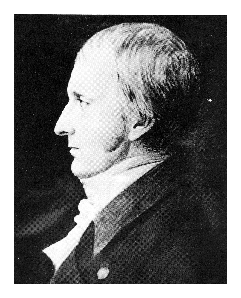
Thomas Wedgwood (1771-1805) was the fourth son of Josiah Wedgwood, the Staffordshire potter and member of the Lunar Society.
Thomas was not very healthy but he travelled a lot and like other members of the Wedgwood family he was interested in experimentation.
His upbringing and contacts with industrialists, inventors and artists provided him with an advanced scientific and cultural education.
Josiah Wedgwood used chemicals to create glazes and colours for his ceramic ware.
Thomas Wedgwood explored different ways of using chemicals to fix an image photographically.
He tried to fix the images made in the camera obscura and h also saw the importance of duplicating pictures.
It was not until 1802, that the strangely titled 'Account of a Method of Copying Paintings upon Glass. Invented by T WEDGWOOD, ESQ', was published by the Royal Institution.
One of his friends, Humphry Davy, was the author and it appears that he had repeated the experiments to check them.
He makes it clear that Wedgwoods original aim, which was unsuccessful, was to make pictures using the camera.
He had more success with attempts to copy pictures by placing semi-transparent paintings, and possibly silhouettes, on surfaces sensitised to light.
He also used solid objects in a similar fashion. But it was not possible to fix the images permanently. They steadily darkened on being exposed to the light.
The article also mentions that images made on white leather were the most successful, a fact that would prove important to later researchers. For example, the research by J.B. Reade in the early 1830s were certainly based on knowledge of Wedgwoods work and developed the hint about success with leather. Reade realised it was something about the tanning of leather that helped and by tanning paper he secured improvements.
And Reades work was known to William Henry Fox Talbot. So it is quite likely that some of Talbots important ideas, such as making photographic copies by contact printing, were suggested by Wedgwoods work.
Although he would have thought of his initial efforts as a failure, Thomas Wedgwood was aware of the importance of recording them, along with other promising ideas, for the benefit of others.
